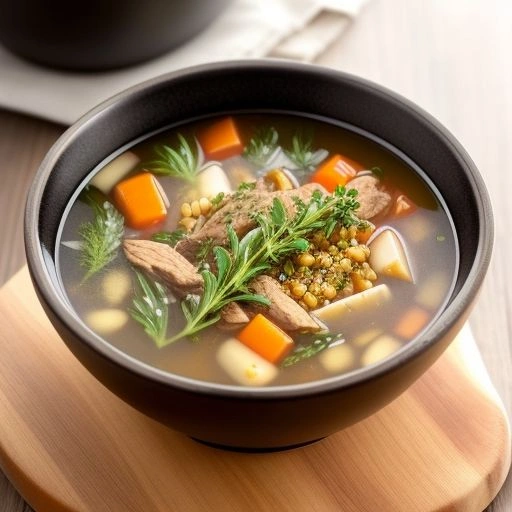Introduction
Porcupine soup is a traditional dish enjoyed in different cultures for its rich flavor and nourishing qualities. This wild game soup is packed with high protein, collagen, and essential minerals, making it a great addition to a balanced diet.
Many indigenous communities have relied on porcupine meat as a valuable food source for centuries. Known for its tender texture and earthy taste, it has been a staple in survival cuisine and rustic cooking traditions. The key to making delicious porcupine soup lies in proper preparation, slow cooking, and the right blend of spices.
Cooking porcupine soup requires careful cleaning and marination to remove any gamey taste. The process enhances the natural flavors and makes the meat tender and flavorful. Using fresh herbs, vegetables, and a rich broth, you can create a savory and aromatic soup that is both comforting and nutritious.
In this guide, you’ll learn how to make porcupine soup step by step. We’ll explore its history, health benefits, essential ingredients, and best cooking techniques. Get ready to master this hearty and exotic dish!
What Is Porcupine Soup and Why Should You Try It?
Porcupine soup is a unique and hearty dish made from wild porcupine meat, slow-cooked with vegetables and spices. This traditional soup has been part of indigenous and survival cuisine for centuries. Its rich flavors and high nutritional value make it a great choice for adventurous food lovers.
The History and Tradition of Porcupine Soup
Many indigenous cultures, including Native American and Southeast Asian communities, have used porcupine meat in their cooking. This wild game soup provided essential nutrients in areas where food sources were scarce. Slow-cooking porcupine meat made it tender, flavorful, and easy to digest.
Porcupine soup is often prepared with local herbs and vegetables, creating a dish that reflects each region’s traditions. In some cultures, it is believed to have medicinal properties, helping with joint health and immune support.
Health Benefits of Porcupine Meat in Soup
Porcupine meat is lean, high in protein, and rich in essential nutrients like iron and collagen. These nutrients support muscle recovery, bone health, and overall wellness. Unlike processed meats, porcupine soup contains no preservatives or additives, making it a clean and natural source of protein.
Collagen from the slow-cooked bones helps improve joint health and skin elasticity. The nutrient-rich broth also aids digestion and boosts immunity. This makes porcupine soup a great meal for athletes, outdoor enthusiasts, and anyone seeking a wholesome diet.
Key Ingredients for the Best Porcupine Soup Recipe
A well-made porcupine soup recipe starts with fresh, high-quality ingredients. Here’s what you’ll need:
- Porcupine meat – Carefully cleaned and cut into small portions.
- Vegetables – Common choices include carrots, onions, garlic, and potatoes.
- Herbs and spices – Thyme, bay leaves, black pepper, and salt enhance the flavor.
- Broth – A rich, slow-cooked stock made from bones or vegetables.
Using wild meat cooking techniques, you can enhance the flavor of porcupine soup. Proper seasoning and slow cooking will help balance the earthy taste of the meat.
By trying porcupine soup, you’ll experience a rare and nutritious dish with deep cultural roots. It’s a great way to expand your culinary skills and explore wild game cuisine.
How to Make Porcupine Soup: A Step-by-Step Guide

Making porcupine soup requires the right ingredients, careful preparation, and slow cooking. This step-by-step guide will help you create a flavorful and nourishing dish. By following these instructions, you can enjoy an authentic wild game soup at home.
Preparing and Cleaning Porcupine Meat
Properly cleaning porcupine meat is essential for the best taste and texture. Start by removing the quills carefully to avoid contamination. After skinning, wash the meat thoroughly with cold water to eliminate any residue.
Marinate the porcupine meat for a few hours to enhance its tenderness. Use lemon juice, vinegar, or saltwater to neutralize the gamey flavor. Cutting the meat into smaller pieces helps it absorb the seasoning better.
Soaking the meat in a mild brine improves texture and reduces any strong odor. Once cleaned and marinated, the meat is ready for cooking.
Cooking Methods for Traditional Porcupine Soup
Slow cooking is the best method for making porcupine soup tender and flavorful. Use a stockpot or a slow cooker to ensure even cooking. Begin by browning the meat in a pot with a small amount of oil for added depth of flavor.
Add chopped onions, garlic, and spices to create a rich base for the broth. Pour in water or homemade stock and bring the mixture to a boil. Lower the heat and let the soup simmer for at least three hours.
Check the meat occasionally to ensure it becomes soft and tender. A longer cooking time allows the flavors to blend well.
Essential Spices and Seasonings for Wild Game Soup
Seasoning porcupine soup correctly is crucial for a balanced taste. Herbs such as thyme, bay leaves, and parsley enhance the broth’s depth. Black pepper, salt, and a touch of paprika bring out the natural flavors of the meat.
Adding root vegetables like carrots and potatoes improves the soup’s texture. Some recipes include wild mushrooms for an earthy flavor. Adjust the seasoning as the soup simmers to create a well-rounded taste.
Using fresh ingredients makes a noticeable difference in the final dish. Experimenting with various herbs allows you to personalize the flavor profile. Once the soup is fully cooked, serve it hot with a side of crusty bread or rice.
Tips for Enhancing the Flavor of Your Porcupine Soup

Creating a rich and flavorful porcupine soup requires careful ingredient selection and proper cooking techniques. Small adjustments can greatly improve the taste and texture of the dish. Follow these tips to elevate your wild game soup.
Choosing the Best Ingredients for a Rich Broth
The quality of the broth determines the depth of flavor in porcupine soup. Use fresh porcupine meat and homemade stock for the best results. A slow-cooked broth made from bones enhances the richness of the soup.
Adding aromatic vegetables like onions, carrots, and celery improves the overall taste. Herbs such as thyme, rosemary, and bay leaves provide an earthy undertone. Fresh ingredients create a more balanced and natural flavor.
A well-seasoned broth allows the porcupine meat to absorb the flavors as it simmers. Using homemade stock instead of water deepens the taste. For more insights on making homemade broths, visit this guide to stock preparation.
Balancing Seasonings and Spices for Better Taste
Spices play a key role in enhancing the natural flavors of porcupine meat. Black pepper, cumin, and paprika add warmth without overpowering the dish. A touch of chili powder provides a mild heat for those who enjoy spice.
Salt should be added in small amounts during cooking to prevent an overly salty broth. Adjust the seasoning as the soup simmers to achieve the right balance. Experimenting with different spice combinations can bring out unique flavors.
Marinating the meat before cooking helps infuse it with extra depth. Lemon juice or vinegar can be used to soften the texture and reduce any gamey taste.
Cooking Techniques to Enhance Flavor and Texture
Slow cooking at a low temperature allows porcupine soup to develop a deeper taste. Letting the soup simmer for several hours results in tender meat and a well-blended broth. Avoid boiling the meat too quickly, as it can become tough.
Sautéing onions, garlic, and spices before adding liquid helps release their natural flavors. Roasting the porcupine meat beforehand can add an extra layer of richness. These techniques bring out the best in the soup’s ingredients.
Allowing the soup to rest before serving enhances the taste. Letting it cool slightly before reheating deepens the flavors. Simple cooking adjustments can make a noticeable difference in the final dish.
Final Thoughts on Cooking the Perfect Porcupine Soup

Mastering porcupine soup requires patience, the right ingredients, and proper cooking techniques. This unique dish offers a rich, earthy flavor that stands out in wild game cuisine. When prepared correctly, it becomes a hearty and satisfying meal.
The Importance of Ingredient Selection
High-quality ingredients make a significant difference in the final taste. Fresh porcupine meat ensures a tender texture and a cleaner flavor. Homemade broth enhances the depth of the soup, making it more flavorful.
Using a variety of vegetables adds both color and nutrition. Root vegetables like carrots and potatoes create a well-balanced, wholesome dish. Fresh herbs help infuse the broth with rich, aromatic notes.
A properly seasoned soup brings out the best in wild game meat. Adjusting the salt, spices, and herbs throughout the cooking process ensures the best flavor.
Cooking Techniques That Make a Difference
The way you cook porcupine soup impacts its texture and taste. Slow simmering allows the flavors to develop fully. Cooking at a low temperature keeps the meat tender and prevents toughness.
Browning the meat before simmering deepens the overall richness. Sautéing onions, garlic, and spices first adds layers of flavor. These small steps create a soup that is well-rounded and deeply satisfying.
Letting the soup rest before serving enhances its taste. Reheating it the next day can make the flavors even more pronounced. Taking your time ensures the best possible result. For additional cooking tips, check out the blogs section.
Bringing Everything Together for a Delicious Meal
Porcupine soup is a dish worth trying for those who enjoy wild game recipes. Its unique flavor profile and rich broth make it a comforting meal. With the right approach, you can create a delicious and nourishing dish.
Experimenting with different spices allows you to personalize the recipe. Adjusting cooking times helps you achieve the perfect texture. Making small tweaks to the recipe ensures a soup that suits your taste.
Cooking porcupine soup is a rewarding experience. It offers a chance to explore traditional flavors while creating a meal that is both hearty and satisfying.
Conclusion:
Porcupine soup is more than just a dish—it’s a flavorful tradition deeply rooted in wild game cooking. Whether you’re a seasoned hunter, a culinary explorer, or simply curious about unique recipes, this hearty soup offers an unforgettable taste experience. By following the right preparation steps, selecting quality ingredients, and using proper cooking techniques, you can create a dish that is both nourishing and satisfying.
The rich, slow-cooked broth, infused with aromatic spices and fresh vegetables, highlights the best flavors of porcupine meat. Each step, from cleaning and marinating the meat to simmering it to perfection, plays a role in achieving the best results. With patience and attention to detail, you can master this recipe and enjoy a deeply comforting meal.
Beyond its delicious taste, porcupine soup is a celebration of traditional cooking methods. It connects us to the past, where people relied on the land for sustenance and used every ingredient with care. Whether you prepare it for a special gathering or as a way to expand your culinary skills, this dish offers a rewarding experience.
Now that you have all the knowledge and techniques, it’s time to bring this recipe to life. Gather your ingredients, follow the step-by-step guide, and enjoy a bowl of rich, savory porcupine soup. Cooking is an adventure—embrace the flavors, enjoy the process, and share the experience with others.

